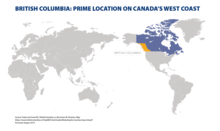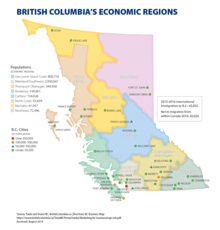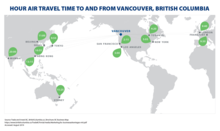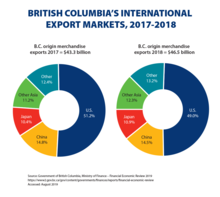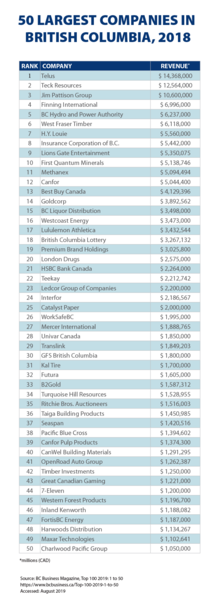
The economy of Alberta is the sum of all economic activity in Alberta, Canada's fourth largest province by population. Alberta's GDP in 2018 was CDN$338.2 billion.

British Columbia is the westernmost province of Canada. Situated between the Pacific Ocean and the Rocky Mountains, the province has a diverse geography, with rugged landscapes that include rocky coastlines, sandy beaches, forests, lakes, mountains, inland deserts and grassy plains. British Columbia borders the province of Alberta to the east; the territories of Yukon and Northwest Territories to the north; the U.S. states of Washington, Idaho and Montana to the south, and Alaska to the northwest. With an estimated population of over 5.6 million as of 2024, it is Canada's third-most populous province. The capital of British Columbia is Victoria, while the province's largest city is Vancouver. Vancouver and its suburbs together make up the third-largest metropolitan area in Canada, with the 2021 census recording 2.6 million people in Metro Vancouver.
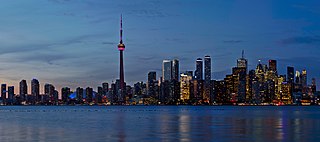
The economy of Canada is a highly developed mixed economy, with the world's tenth-largest economy as of 2023, and a nominal GDP of approximately US$2.117 trillion. Canada is one of the world's largest trading nations, with a highly globalized economy. In 2021, Canadian trade in goods and services reached $2.016 trillion. Canada's exports totalled over $637 billion, while its imported goods were worth over $631 billion, of which approximately $391 billion originated from the United States. In 2018, Canada had a trade deficit in goods of $22 billion and a trade deficit in services of $25 billion. The Toronto Stock Exchange is the tenth-largest stock exchange in the world by market capitalization, listing over 1,500 companies with a combined market capitalization of over US$3 trillion.

Surrey is a city in British Columbia, Canada. It is located south of the Fraser River on the Canada–United States border. It is a member municipality of the Metro Vancouver regional district and metropolitan area. Mainly a suburban city, Surrey is the province's second-largest by population after Vancouver and the third-largest by area after Abbotsford and Prince George. Seven neighbourhoods in Surrey are designated town centres: Cloverdale, Fleetwood, Guildford, Newton, South Surrey, and City Centre encompassed by Whalley.
The British Columbia Hydro and Power Authority, operating as BC Hydro, is a Canadian electric utility in the province of British Columbia. It is the main electricity distributor, serving more than 4 million customers in most areas, with the exception of the City of New Westminster, where the city runs its own electrical department and portions of the West Kootenay, Okanagan, the Boundary Country and Similkameen regions, where FortisBC, a subsidiary of Fortis Inc. directly provides electric service to 213,000 customers and supplies municipally owned utilities in the same area. As a provincial Crown corporation, BC Hydro reports to the BC Ministry of Energy, Mines and Low Carbon Innovation, and is regulated by the British Columbia Utilities Commission (BCUC). Its mandate is to generate, purchase, distribute and sell electricity.
Fort Nelson is a community in northeast British Columbia, Canada, within the Northern Rockies Regional Municipality (NRRM). It held town status prior to 6 February 2009, when it amalgamated with the former Northern Rockies Regional District to form the NRRM, becoming its administrative centre. The NRRM is the first regional municipality in the province.

Kitimat is a district municipality in the North Coast region of British Columbia, Canada. It is a member municipality of the Regional District of Kitimat–Stikine regional government. The Kitimat Valley is part of the most populous urban district in northwest British Columbia, which includes Terrace to the north along the Skeena River Valley. The city was planned and built by the Aluminum Company of Canada (Alcan) during the 1950s. Its post office was approved on 6 June 1952.

Petroleum production in Canada is a major industry which is important to the overall economy of North America. Canada has the third largest oil reserves in the world and is the world's fourth largest oil producer and fourth largest oil exporter. In 2019 it produced an average of 750,000 cubic metres per day (4.7 Mbbl/d) of crude oil and equivalent. Of that amount, 64% was upgraded from unconventional oil sands, and the remainder light crude oil, heavy crude oil and natural-gas condensate. Most of the Canadian petroleum production is exported, approximately 600,000 cubic metres per day (3.8 Mbbl/d) in 2019, with 98% of the exports going to the United States. Canada is by far the largest single source of oil imports to the United States, providing 43% of US crude oil imports in 2015.

Canada has access to all main sources of energy including oil and gas, coal, hydropower, biomass, solar, geothermal, wind, marine and nuclear. It is the world's second largest producer of uranium, third largest producer of hydro-electricity, fourth largest natural gas producer, and the fifth largest producer of crude oil. In 2006, only Russia, the People's Republic of China, the United States and Saudi Arabia produce more total energy than Canada.
FortisBC is a Canadian owned, British Columbia based regulated utility providing natural gas, and electricity. FortisBC has approximately 2,600 employees serving more than 1.2 million customers in 135 B.C. communities and 58 First Nations communities across 150 Traditional Territories.

Foreign direct investment in Iran (FDI) has been hindered by unfavorable or complex operating requirements and by international sanctions, although in the early 2000s the Iranian government liberalized investment regulations. Iran ranks 62nd in the World Economic Forum's 2011 analysis of the global competitiveness of 142 countries. In 2010, Iran ranked sixth globally in attracting foreign investments.

John Yap is a Canadian politician and former banker. He represented the electoral district of Richmond-Steveston in the Legislative Assembly of British Columbia from 2005 to 2020, as part of the BC Liberal caucus. During his time in government, he served as Minister of State for Climate Action, Minister Responsible for Multiculturalism, and Minister of Advanced Education, Innovation and Technology in the cabinets of premiers Gordon Campbell and Christy Clark.
Through the 1996 Electric Utilities Act the Alberta's deregulated electricity market began.
Coal reserves in Canada rank 13th largest in the world at approximately 10 billion tons, 0.6% of the world total. This represents more energy than all of the oil and gas in the country combined. The coal industry generates CDN$5 billion annually. Most of Canada's coal mining occurs in the West of the country. British Columbia operates 9 coal mines, Alberta nine, Saskatchewan three and New Brunswick one. Nova Scotia operates several small-scale mines, Westray having closed following the 1992 disaster there.

Doug Donaldson is a Canadian politician, who represented the Stikine electoral district Legislative Assembly of British Columbia from 2009 to 2020. He is a member of the British Columbia New Democratic Party and was first elected as a Member of the Legislative Assembly in the 2009 election and re-elected in the 2013 and 2017 elections. During the 41st Parliament (2017-2020) he served in the Executive Council as the Minister of Forests, Lands and Natural Resource Operations, and Rural Development. In that role he led the government through adopted several bills including amending the Heritage Conservation Act to create a legal duty-to-report discoveries of specific sites or objects with potential heritage value and amending the Forest Act to insert consideration of the "public interest" in decisions to approve the forestry dispositions. As a member of the official opposition in the 39th and 40th Parliaments he served in various critic and deputy roles at different times, such as on issues relating to mines, energy, finance and children and family development issues. He introduced one private member bill to amend the Oil and Gas Activities Act to prohibit the conversion of natural gas pipelines to transmit oil or diluted bitumen.

Cannabis in British Columbia (BC) relates to a number of legislative, legal, and cultural events surrounding the use and cultivation of cannabis in the Canadian province of British Columbia. As with the rest of Canada, cannabis became legalized on 17 October 2018, following the enactment of the Cannabis Act, or Bill C-45. Prior to that, though the drug was illegal in Canada, its recreational use was often tolerated and was more commonplace in the province of BC as compared to most of the rest of the country. The province's inexpensive hydroelectric power and abundance of water and sunshine—in addition to the many hills and forests —made it an ideal cannabis growing area. The British Columbia cannabis industry is worth an estimated CA$2 billion annually and produces 36.6 percent of all Canadian cannabis. The province is also the home of the cannabis activist and businessman Marc Emery.

The economy of the Western Cape in South Africa is dominated by the city of Cape Town, which accounted for 72% of the Western Cape's economic activity in 2016. The single largest contributor to the region's economy is the financial and business services sector, followed by manufacturing. Close to 30% of the gross regional product comes from foreign trade with agricultural products and wine dominating exports. High-tech industries, international call centres, fashion design, advertising and TV production are niche industries rapidly gaining in importance.
Jas Johal is a Canadian politician and media personality. He served as Member of the Legislative Assembly (MLA) of British Columbia for the electoral district of Richmond-Queensborough in the 41st Parliament of British Columbia (2017-2020), as part of the British Columbia Liberal Party caucus.

LNG Canada Development Inc. is an industrial joint venture established to construct a liquefied natural gas (LNG) export terminal in Kitimat, British Columbia, Canada. The consortium is led by Shell and also includes Petronas, PetroChina, Mitsubishi, and Korea Gas. The Kitimat terminal will export LNG produced in the Montney Formation near Dawson Creek, B.C by the project's partners.
The Ministry of Environment and Climate Change Strategy is a ministry of the government of British Columbia in Canada. The ministry is responsible for the effective protection, management and conservation of the province's natural resources. It is currently overseen by George Heyman.

